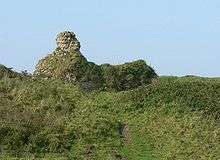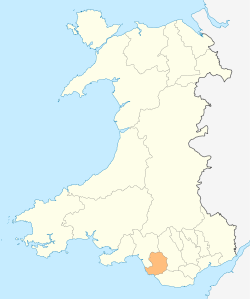Kenfig Castle

Kenfig Castle is a ruined castle in Bridgend County Borough in Wales that came to prominence after the Anglo-Norman invasion of Wales in the late eleventh century.
History
An early reference to a castle at Kenfig can be found in 1080, when Iestyn ap Gwrgan was said to have refortified it, but probably this was a different structure to that raised alongside the town that developed there in the mid-twelfth century. In its day it was an important Norman stronghold and was built by Robert, Earl of Gloucester in the early 12th century. It was set on a mound with the river to the west and north. The 14 m (46 ft) square, free-standing keep had an entrance at the southwest corner. It was a tall, elegant structure with buttresses of dressed stone at each corner and the centre of each side, as well as a hall and offices. The bailey lies to the south, surrounded by the remains of a bank and ditch. The castle acted as an administrative centre and by 1183, a borough had grown up to the south.[1][2]
The castle was sacked by the Welsh on at least six occasions, in 1167, 1183, 1232, 1242, 1294-5, by Morgan ap Maredudd during the revolt of Madog ap Llywelyn, and again in 1316 during the revolt of Llywelyn Bren. In the early fourteenth century the castle was substantially reconstructed. The ramparts were removed to make the court more level and a curtain wall was erected, with a large gatehouse leading to the borough. The tower was also substantially rebuilt.[2]
By the late fifteenth century both Kenfig old town and the castle had been abandoned because of encroaching sand dunes. John Leland wrote in about 1539, "There is a little village on the est side of Kenfik, and a castel, booth in ruine and almost shokid (choked) and devourid with the sandes that the Severn Se ther castiith up".[3]

In the 1920s and early 1930s much of the sand was excavated as an Archaeological dig.[2] The sands re-invaded the site and only the top of the keep is now visible.[1]
See also
- List of Scheduled Monuments in Bridgend
- List of castles in Wales
- Castles in Great Britain and Ireland
References
- 1 2 Thomas, Jeffrey L. (2009). "Kenfig Castle". Castles of Wales. Retrieved 5 April 2016.
- 1 2 3 Coflein.gov.uk NPRN: 300455. Glamorgan-Gwent Archaeological Trust (search for PRN 00148m). Cadw SAM: GM042: Kenfig Castle & Medieval Town
- ↑ The Itinerary in Wales of John Leland in or about the years 1536-1539. Ed. Toulmin-Smith, L. London, 1906. Vol 3, p29.
- Ian N. Soulsby, The Towns of Medieval Wales (Chichester, 1983), p. 150.
Coordinates: 51°31′49″N 3°43′48″W / 51.5303°N 3.7300°W
